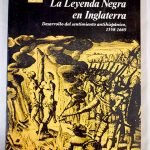
Contenidos
La invisibilidad del antiracismo en los libros de texto de U.S
En el libro se relata «Las patrañas históricas» que descubrió James Loewen, cuando leyó y analizó el contenido de 18 de los principales libros de texto historia que se utilizan en las escuelas de Estados Unidos
James Loewen
Historiador y sociólogo Estadounidense, dedicó mas de 1 año, a analizar libros de texto que se utilizaban en las escuelas de U.S, encontrando graves errores.
Patrañas que me contó mi profe(Loewen)
James Loewen
Última actualización el 2021-05-20 / Enlaces de afiliados / Imágenes de la API para Afiliados
Lies My Teacher Told Me:
Everything Your American History Textbook Got Wrong
James Loewen
Última actualización el 2021-07-20 / Enlaces de afiliados / Imágenes de la API para Afiliados
The Invisibility of antiracism in American History
It is not only radical or currently unfashionable ideas
that the texts leave out—it is all ideas, including those
of their heroes.
—FRANCES FITZGERALD
You may dispose of me very easily. I am nearly
disposed of now. But this question is still to be settled—
this Negro question, I mean; the end of that is not yet.
—JOHN BROWN, 1859
I am here to plead his cause with you. I plead not for
his life, but for his character—his immortal life; and so
it becomes your cause wholly, and is not his in the
least.
—HENRY DAVID THOREAU, “A PLEA FOR CAPTAIN JOHN BROWN,” 1859
We shall need all the anti-slavery feeling in the country,
and more; you can go home and try to bring the people
to your views, and you may say anything you like about
me, if that will help. . . . When the hour comes for
dealing with slavery, I trust I will be willing to do my
duty though it cost my life.
—ABRAHAM LINCOLN TO ABOLITIONIST UNITARIAN MINISTERS, 1862
The treatment of Brown has changed
The treatment of Brown, like the treatment of slavery and Reconstruction, has changed in American history textbooks. From 1890 to about 1970, John Brown was insane. Before 1890 he was perfectly sane, and after 1970 he has slowly been regaining his sanity. Before reviewing six more textbooks in 2006-07, I had imagined that they would maintain this trend, portraying Brown’s actions so as to render them at least intelligible if not intelligent. In their treatment of Brown,
however, the new textbooks don’t differ much from those of the 1980s, so I shall discuss them all together. Since Brown himself did not change after his death— except to molder more—his mental health in our textbooks provides an inadvertent index of the level of white racism in our society. Perhaps our new textbooks suggest that race relations circa 2007 are not much better than circa
1987.
Kansas-Nebraska Act (1854)
In the eighteen textbooks I reviewed, Brown makes two appearances: Pottawatomie, Kansas, and Harpers Ferry, Virginia. Recall that the 1854 «Kansas-Nebraska Act«, tried to resolve the question of slavery through “popular sovereignty.” The practical result of leaving the slavery decision to whoever settled in Kansas was an ideologically motivated settlement craze.
In May 1856 hundreds of pro-slavery “border ruffians,” as they came to be called, raided the
free-soil town of Lawrence, Kansas, killing two people, burning down the hotel, and destroying two printing presses.
The portrait
At left is John Brown as he appeared in 1858. He looked like a middle-aged businessman—which he was. He grew a beard later that year, partly as a modest attempt to disguise himself after becoming wanted for helping eleven African Americans escape slavery in Missouri. Few Americans recognize this portrait.
At right is John Brown as he looked in 1937 to John Steuart Curry, who painted a version of his portrait on the walls of the Kansas State Capitol. This Brown is gaunt and deranged, which he had become in our culture by 1937. Astoundingly, at the start of the new millennium, American Journey chose a variant of this painting as its only portrait of Brown. Many Americans can name this man.
Brown’s ideological influence
Clearly, Brown’s contemporaries did not consider him insane. Brown’s ideological influence in the month before his hanging, and continuing after his death, was immense. He moved the boundary of acceptable thoughts and deeds regarding slavery. Before Harpers Ferry, to be an abolitionist was not quite acceptable, even in the North. Just talking about freeing slaves—advocating immediate emancipation—was behavior at the outer limit of the ideological continuum. By engaging in armed action, including.
Virginia executed John Brown
When Virginia executed John Brown on December 2, making him the
first American since the founding of the nation to be hanged as a traitor, church
bells mourned in cities throughout the North.
“The gaze of Europe is fixed at this moment on America,” wrote Victor Hugo from France. Hanging Brown, Hugo predicted, “will open a latent fissure that will finally split the Union certainly shatter the American Democracy. You preserve your shame but you kill your glory.”
John Brown’s Body
As the war came, as thousands of Americans found themselves making the same commitment to
face death that John Brown had made, the force of his example took on new relevance. That’s why soldiers marched into battle singing “John Brown’s Body.” Two years later, church congregations sang Julia Ward Howe’s new words to the song: “As He died to make men holy, let us die to make men free”—and the identification of John Brown and Jesus Christ took another turn. The next year saw the 54th Massachusetts Colored Regiment parading through Boston to the tune, en route to its heroic destiny with death in South Carolina, while William Lloyd Garrison surveyed the cheering bystanders from a balcony, his hand resting on a bust of John Brown. In February 1865 another
Massachusetts colored regiment marched to the tune through the streets of Charleston, South Carolina.
White America abandoned racial idealism
That was the high point of old John Brown. At the turn of the century, as Southern and border states disfranchised African Americans, as lynchings proliferated, as blackface minstrel shows came to dominate American popular culture, white America abandoned the last shards of its racial idealism.
Other white civil rights workers
A history published in 1923 makes plain the connection to Brown’s insanity: “The farther
we get away from the excitement of 1859 the more we are disposed to consider this extraordinary man the victim of mental delusions.”
Not until the civil rights movement of the 1960s was white America freed from enough of its
racism to accept that a white person did not have to be crazy to die for black equality. In a sense, the murders of Mickey Schwerner and Andrew Goodman in Mississippi, James Reeb and Viola Liuzzo in Alabama, and various other white civil rights workers in various other Southern states during the 1960s liberated textbook writers to see sanity again in John Brown. Rise of the American Nation, written in 1961, calls the Harpers Ferry plan “a wild idea, certain to fail,” while in Triumph of the American Nation, published in 1986, the plan becomes “a bold idea, but almost certain to fail.”
Textbooks have erased him
John Brown might provide a defense against such global attacks on whites, but, unfortunately, American history textbooks have erased him as a usable character.
No black person who met John Brown thought him crazy. Many black leaders of the day—Martin Delaney, Henry Highland Garnet, Frederick Douglass, Harriet Tubman, and others—knew and respected Brown. Only illness kept Tubman from joining him at Harpers Ferry. The day of his execution blackowned businesses closed in mourning across the North. Frederick Douglass called Brown “one of the greatest heroes known to American fame.
Lincoln-Douglas debates
If textbooks recognized Lincoln’s racism, students would learn that racism not only affects Ku Klux Klan extremists but has been “normal” throughout our history. And as they watched Lincoln struggle with himself to apply America’s democratic principles across the color line, students would see how ideas can develop and a person can grow.
In conversation, Lincoln, like most whites of his century, referred to blacks as “niggers.” In the Lincoln-Douglas debates, he sometimes descended into explicit white supremacy, as we saw in the last chapter. Lincoln’s ideas about race were more complicated than Douglas’s, however. The day after Douglas declared for white supremacy in Chicago, saying the issues were “distinctly drawn,” Lincoln replied and indeed drew the issue distinctly:
I should like to know if taking this old Declaration of Independence,
which declares that all men are equal upon principle, and making
exceptions to it—where will it stop? If one man says it does not mean a
Negro, why does not another say it does not mean some other man? If
that Declaration is not . . . true, let us tear it out! [Cries of “no, no!”] Let
us stick to it then, let us stand firmly by it then.
No textbook quotes this passage, and every book but one leaves out Lincoln’s thundering summation of what his debates with Douglas were really about:
“That is the issue that will continue in this country when these poor tongues of Judge Douglas and myself shall be silent. It is the eternal struggle between these two principles—right and wrong—throughout the world.”
Lincoln personally opposed slavery
Most of the textbooks mention that Lincoln “personally” opposed slavery. Two even quote his 1864 letter: “If slavery isn’t wrong, then nothing is wrong.”
However, most textbook authors take pains to separate Lincoln from undue idealism about slavery. They venerate Lincoln mainly because he “saved the Union.” By far their favorite statement of Lincoln’s, quoted or paraphrased by fifteen of the eighteen books, is his letter of August 22, 1862, to Horace Greeley’s New York Tribune:
My paramount object in this struggle is to save the Union, and is not
either to save or to destroy slavery. If I could save the Union without
freeing any slave, I would do it; and if I could save it by freeing all the
slaves, I would do it; and if I could save it by freeing some and leaving
others alone, I would also do that. What I do about slavery and the
colored race I do because I believe it helps to save this Union; and what I
forbear, I forbear because I do not believe it would help to save the
Union. . . .
By emphasizing this quote, most textbooks present a Lincoln who was morally indifferent to slavery and certainly did not care about black people. As Pathways to the Present puts it, “Lincoln came to regard ending slavery as one more strategy for ending the war.” Ironically, this is also the Lincoln whom black nationalists present to African Americans to persuade them to stop thinking well of him.
To remove all context
To present such a Lincoln, the textbooks have to remove all context. The very first thing they omit is the next point Lincoln made: “. . . I have here stated my purpose according to my view of official duty, and I intend no modification of my oft-expressed personal wish that all men, everywhere could be free.” That says something quite different about slavery, of course. So all but three textbooks leave that part out.
Riot of 1863
Illustrating “PUBLIC LIBERTY and PRIVATE RIGHT,” Nast shows the New York City draft riot of 1863: white thugs are exercising their “right” to beat and kill African Americans, including a child held upside down.
The Confederacy
White Southerners founded the Confederacy on the ideology of white supremacy. According to Alexander Stephens, vice president of the Confederacy: “Our new government’s foundations are laid, its cornerstone rests, upon the great truth that the Negro is not equal to the white man, that slavery— subordination to the superior race—is his natural and normal condition.”
States’ rights did not motivate secession
The last chapter showed that concern for states’ rights did not motivate secession. Moreover, as the war continued, the Confederacy began to deny states’ rights within the new nation. As early as December 1862, President Jefferson Davis denounced states’ rights as destructive to the Confederacy. The mountainous counties in western Virginia bolted to the Union. Confederate troops had to occupy east Tennessee to keep it from emulating West Virginia. Winn Parish, Louisiana, refused to secede from the Union. Winston County, Alabama, declared itself the Free State of Winston. Unionist farmers and woodsmen in Jones County, Mississippi, declared the Free State of Jones. Every Confederate state except South Carolina supplied a regiment or at least a company of white soldiers to the Union army, as well as many black recruits.
Contradictions and Confederate soldiers
In part, owing to these contradictions, some Confederate soldiers switched sides, beginning as early as 1862. When Sherman made his famous march to the sea from Atlanta to Savannah, his army actually grew in number, because thousands of white Southerners volunteered along the way. Meanwhile, almost two-thirds of the Confederate army opposing Sherman disappeared through
desertion.
Eighteen thousand slaves also joined Sherman, so many that the army had to turn some away. Compare these facts with the portrait common in our textbooks of Sherman’s marauders looting their way through a united South.
The increasing ideological confusion in the Confederate states, coupled with the increasing ideological strength of the United States, helps explain the Union victory. “Even with all the hardships,” Carleton Beals has noted, “the South up to the very end still had great resources and manpower.”
Ideas or ideologies
Why are textbooks silent regarding ideas or ideologies as a weakness of the Confederacy?
The Civil War was about something, after all, and that something even influenced its outcome. Textbooks should tell us what it was.
This silence has a history. Throughout the twentieth century, textbooks presented the Civil War as a struggle between “virtually identical peoples.” This is all part of the unspoken agreement, reached during the nadir of race relations in the United States (1890-1940), that whites in the South were as American as whites in the North.
White Northerners and white Southerners reconciled on the backs of African Americans in those years, while the abolitionists became the bad guys.
History textbooks
To this day, history textbooks still present Union and Confederate sympathizers as equally idealistic. The North fought to hold the Union together, while the Southern states fought, according to The American Way, “for the preservation of their rights and freedom to decide for themselves.” Nobody fought to preserve racial slavery; nobody fought to end it. As one result, unlike the Nazi swastika, which lies disgraced, even in the North whites still proudly display the Stars and Bars of the Confederacy on den walls, license plates, Tshirts, and high school logos. Even some (white) Northerners vaguely regret the defeat of the “lost cause.” It is as if racism against blacks could be remembered with nostalgia.
The Confederacy finally won
In this sense, long after Appomattox, the Confederacy finally won.Five days after Appomattox, President Lincoln was murdered. His martyrdom pushed Union ideology one step further. Even whites who had opposed emancipation now joined to call Lincoln the great emancipator.
Risked her life
The white woman at left, whom textbooks would call a “carpetbagger,” could hardly expect to grow rich teaching school near Vicksburg, where this illustration was done. This woman risked her life to bring basic literacy to African American children and adults during Reconstruction.
And textbooks still invoke greed to “explain” whites who believed blacks should have civil and political rights. Of course, authors might use the notion of private gain to disparage every textbook hero from Christopher Columbus and the Pilgrims through George Washington to Jackie Robinson. They don’t, though.
Textbooks attribute selfish motives only to characters with whom they have little sympathy, such as the idealists in Reconstruction. The negatives then stick in the mind, cemented by the catchy pejoratives carpetbaggers and scalawags, while the qualifying phrases—many white southerners—are likely to be forgotten.
Everyone who supported black rights in the South during Reconstruction did so at personal risk. At the beginning of Reconstruction, simply to walk to school to teach could be life-threatening. Toward the end of the era, there were communities in which simply to vote Republican was life-threatening. While some Reconstructionists undoubtedly achieved economic gain, it was a
dangerous way to make a buck. Textbooks need to show the risk, and the racial idealism that prompted most of the people who took it.
The recommended book
Lies My Teacher Told Me
Book: -Lies My Teacher Told Me: Everything Your American History Textbook Got Wrong (James Loewen)











